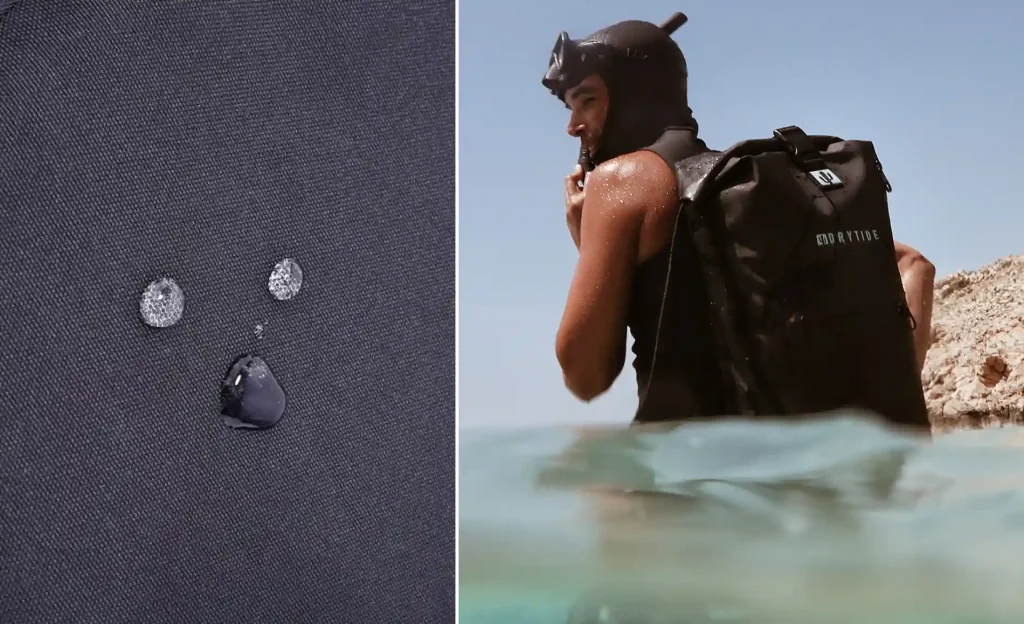8 Frequently Asked FAQs About Waterproof Bags
- Latest update

Written by Jason
Table of Contents
FAQ 1: What exactly is a waterproof bag

A waterproof bag is designed to keep water out and prevent it from damaging the contents.
They are sometimes called dry bags. These bags are necessary for any activities that involve exposure to water, including kayaking, boating and playing on the beach. They can also be used for hiking in wet conditions or for everyday use. Here are the main characteristics of waterproof bags.
- Material Waterproof bags are usually made of robust, water-resistant material such as nylon, polyester, nylon or TPU. These materials are usually treated with laminates or coatings to improve their water repellency.
- Construction The construction of waterproof bags is essential. The seams are usually welded together or sealed to prevent water from leaking in.
- Closed Systems These bags usually have specialized closures like waterproof zippers or fold-over tops. Roll-top closures, for example, involve rolling the top down several times, then locking it. This creates a barrier to water entry.


- Durability Waterproof bags can withstand harsh conditions and are often resistant to abrasion. They are suitable for outdoor use.
- Design Variations They are available in various sizes and designs, from small pouches and wallets to large duffles or backpacks that can hold camping gear.
- Submersion protection While all waterproof bags are designed to protect against rain, splashes and contents can be protected even when the bag is briefly submersible.
- Applications These bags are used by people who want to protect their sensitive electronic equipment, such as cameras, from water damage. They can also be used for outdoor sports and marine activities.
FAQ 2: Can waterproof bags be 100% waterproof?
When it comes to “waterproof”, can be misleading, since the level of water resistance can differ significantly between different products. The design, construction, and materials of a bag will determine whether it is waterproof or not. This is a closer look:
- Material & Construction: Waterproof bags are made of impermeable materials such as PVC, TPU or treated nylon and Polyester. To prevent leakage, seams should be welded, or sealed tightly, and not simply stitched.
- Closer System : The type and location of the closure is the main factor in determining whether a bag will be waterproof. Waterproof bags are often made with roll-top closures. The top of the bag must be rolled tightly down and secured. Other effective closures include waterproof zippers and fold over tops.
- Waterproof Rates Some bags are rated based on their waterproof abilities, using the IP (Ingress Protection) rating system. A higher IP rating (e.g. IP67 or IP68), indicates a greater level of water resistance. This means that the bag is able to be submerged without allowing water into it for a certain period.
- Purpose: The waterproof definition varies depending on the bag’s intended use. A bag intended for kayaking, boating, or other water sports may be expected to resist submersion. However, a backpack designed to protect contents from heavy rain in the city might not need to.
- Brand claims vs. reality: It is important to distinguish between marketing claims and real performance. Some products labeled “waterproof” may only be splash-proof or water-resistant, meaning that they can handle light rainfall or splashes of water but not prolonged or full exposure to water.
- User Tests and Reviews: The water-resistance of a bag can often be determined by how it’s used in real-life situations and the feedback provided by users. Some users test a bag to see if it is water-resistant.
FAQ 3: How can I test the waterproofness a bag easily?
Firstly, let’s watch an interesting video of dry bags waterproofness testing.
It’s important to test the waterproofness of your bag when it is exposed to large amounts of water. Air test is the easiest and simplest way to test waterproofness. Below are the steps you can take.
Air Test
- Inflate the bag gently by blowing in air.
- Seal the bag.
- You can also submerge the bag in water and listen to hear if air escapes. Submerge the bag under water to check for bubbles that indicate a leak. This test will show you the integrity of the seal, not the fabric’s ability to be waterproof.
There is another convenient option.
Paper Towel Test:
- Line the bag: Place paper towel or a clean, dry cloth in the entire bag.
- Seal and expose the bag to water: Seal it and then expose it in water. You can test the waterproofing by running a tap or spraying water in a bath.
- Open the bag after exposure and inspect the paper towel for signs of dampness. If the towels are completely dry, then the bag is waterproof.
Always follow the instructions provided by the manufacturer. They may have specific guidelines or warnings regarding their product. It is important to check the waterproofness regularly, and especially before you use it in a critical situation.
FAQ 4: What materials are commonly used in waterproof bags? What is the difference between waterproof bags and other types of bags?
The bags can be made from different materials. Each material has its own unique properties that are tailored to suit the needs of various environments and situations. The most common materials used are PVC (Polyvinyl Chloride), Thermoplastic Polyurethane (TPU), Nylon and Polyester.
- PVC (Polyvinyl Chloride),
- PVC is known to be durable and resistant to chemicals and water. This is a tough material that can handle harsh conditions.
- They are often used for heavy-duty applications such as marine and outdoor activities, where toughness is needed.
- PVC is thicker, more durable and less flexible than other materials. It is ideal for extreme environments but heavier and less flexible.
- TPU (Thermoplastic Polyurethane).
- TPU is known for its high resistance to oil, lubricants, and abrasion. It is also more environmentally friendly and recyclable than PVC. Here are some more differences:
- It is commonly used when flexibility and weight matter, such as in hydration bags, lightweight drybags, and high-end backpacks.
- TPU bags can be lighter and more flexible than PVC bags, but they are also more expensive.
- Nylon
- Nylon is strong and lightweight. Its water resistance is significantly improved when coated with silicone or TPU.
- It is used in a wide range of bags from lightweight drybags to durable backpacks. The type of coating used will determine the wide range of uses.
- Nylon bags are a great compromise between durability and weight, especially those that have a high denier count. These bags are not waterproof by nature, but they rely on coatings for water resistance.
- The use of Polyester
- Polyester is more UV resistant and less prone to fading than nylon. It is also lightweight and durable.
- Commonly used in waterproof bags including backpacks, travel bags and everyday bags. The coating is what determines its waterproof properties, just like nylon.
- Polyester has a higher UV resistance than nylon and is therefore preferred for prolonged sunlight exposure. Due to its versatility, it’s used in many consumer products.
Each material has pros and cons. The type of activity, durability requirements, weight, and environmental considerations will all influence the choice. These materials are often combined in high-quality waterproof bags, which take advantage of each material’s strengths for optimal performance.
FAQ 5: What is the best way to maintain and clean a waterproof bag?
Cleaning and maintaining your dry bag is essential to ensuring that it keeps your belongings dry. Following are some tips on how to care for your waterproof bag.
- Routine Cleaning
- Light Clean: To remove light dirt or stains, wipe the bag using a damp cloth. Use lukewarm or cold water, without detergent.
- Thorough Clean If the bag has been heavily soiled clean it using mild soap and warm water. Gently scrub the bag with a soft sponge or brush. Avoid harsh chemicals, such as bleach or strong detergents. These can damage the waterproofing.
- Drying
- Let the bag completely air dry before storing. Avoid using a hairdryer or tumble dryer as the heat will damage the material. It is best to let the material dry naturally.
- Stores
- The bag should be stored in a dry, cool place away from heat and direct sunlight. The material can be degraded over time by prolonged exposure to UV light.
- Store the bag dry. Moisture can cause mildew or odor.
- Avoid storing the bag rolled or folded if it has a roll top closure. This can cause creases in the material that will weaken over time. Store it loosely or hang it.
- Seal Maintenance
- Check the seals or closures on a regular basis for signs of wear and damage. To keep zippers working smoothly, clean them with fresh water. You can also lubricate the zippers occasionally with silicone-based lubricant.
- Avoid Overloading
- Avoid overloading your bag. Excessive weight can cause the seams to stretch and the closures to fail, resulting in leaks.
- Regular Checks
- Check the bag periodically for signs of wear, especially in areas that are subjected to high stress, such as straps, seams and closures. Minor damage that is detected early can be prevented from becoming a bigger problem.
- Repairing Damage
- Use a repair kit for waterproof materials to fix minor tears and punctures. If the damage is severe, you may want to consider hiring a professional or consulting with the manufacturer.
- Avoiding rough surfaces
- Avoid dragging the bag across rough surfaces. This can cause abrasions, which may compromise its waterproof integrity.
Follow these tips to maintain and clean your waterproof bag so that it remains in good shape, providing effective protection from water for longer. Always check the instructions for your bag’s manufacturer to see if there are any specific care instructions.
FAQ 6: What’s the Difference Between Waterproof and Water-Resistant Bags?

Often, the terms “waterproof”, “water-resistant”, and “water-resistant” can be used interchangeably. However, they represent different levels of protection from water. It is important to know the difference between these two types when selecting a bag, particularly for certain activities or conditions. Here is a breakdown of their differences:
- Waterproof Bags
- Definition : Waterproof bags have been designed to be impervious against water. Waterproof bags provide total protection from water penetration, which means that the contents of the bag will remain dry when submerged for a certain period in water.
- Construction and Material These bags are usually made of robust materials such as PVC, treated nylon, polyester, and TPU. To prevent leakage, the seams are often welded or taped.
- Closed Systems They are often equipped with specialized closure systems, such as roll-tops, waterproof zippers or hermetic seals to ensure an airtight seal.
- Use: Perfect for activities that involve the bag being submerged in water. For example, kayaking or boating.
- Rating System Some waterproof bags can be rated by standards such as the IP (Ingress protection) rating which shows their level of water resistance.
- Water-Resistant Bags
- Definition : Water-resistant bags are able to withstand some water, but not completely. Water-resistant bags can be used to protect against a light shower, a few splashes or moisture, but they are not intended for prolonged submersion or complete immersion in water.
- Material & Construction: They are made of similar materials to waterproof bags, but they may not have the same seals or closures. Fabrics can be treated to repel water.
- Closure System: The zippers and flaps on water-resistant bags are designed to resist but not prevent water penetration.
- Use: This bag is suitable for daily use, outdoor activities that are not too strenuous, and situations in which the bag will not be submerged.
- Rating System: The water-resistance of a product is not always quantified. It may instead be described as’resistant to light rain’ or “splash proof”.
Differences between and
- Levels of Protection: Water-resistant bags are only limitedly protected against moisture, but offer complete protection from water.
- Intended Usage: Waterproof bag is for extreme conditions, where there will be a significant amount of water exposure. On the other hand, water-resistant bag is for daily use or a light exposure to water.
- Construction & Materials: While both bags may use similar materials and construction, waterproof bags require a more rigorous construction. They must have sealed seams with more effective closures.
Consider the conditions under which you will use your bag when choosing a bag. A waterproof bag is necessary for activities that involve heavy exposure to water, or possible submersion. A water-resistant bag is sufficient for general use, where there may be light rain or splashes.
FAQ 7: Can waterproofing damage occur?
The waterproofing on a bag, or any material that is waterproof can be damaged with time or by certain conditions. Waterproofing is not a permanent solution and can be affected by a variety of factors.
- Wear & Tear: The material of a waterproof pouch can be damaged by regular use, particularly in harsh conditions. The material can be damaged by abrasion on rough surfaces, objects with sharp edges, or constant folding.
- UV Exposition: Prolonged sun exposure can weaken or degrade waterproof materials. This is especially true for certain fabrics and coatings. UV rays may cause materials to become brittle and susceptible to tears or cracks.
- Chemical damage: Exposed to harsh chemicals, oil, or pollutants, the waterproof fabric or coating can be damaged. Some cleaning agents are harmful to waterproof materials if they’re not designed for them.
- Heat Fluctuations : Extreme heat or temperature fluctuations can damage waterproof materials. A waterproof bag left in a warm car, for example, can compromise the seal.
- Improper storage: If you store the bag in an inappropriate way, such as in damp conditions, or folded into tight spaces, it can cause issues like mildew or material degradation.
- Poor maintenance: Failure to maintain and clean the bag properly or using inappropriate cleaning products and methods can compromise its waterproof qualities. You can look at the maintenance methods.
- Sealing and Closure Damage Damage to the sealing mechanism, such as roll-top closures or water-resistant zippers, may compromise the bag’s capability to keep out the water.
FAQ 8: How Do I Choose the Right Size for a Waterproof Bag?
When choosing the size of a waterproof bag, you should consider several factors related your needs and intended use. Here are some guidelines that will help you choose the right size:
- Purpose, Activity and :
- Determine the primary activity you will use the bag for (e.g. kayaking, hiking or cycling). Bags are required for different activities.
- You may need a larger bag to fit your gear, clothes, and food for water sports such as kayaking or boating. You might choose a medium-sized bag that balances comfort and capacity for hiking or cycling.
- List of items to carry :
- List the items that you intend to carry inside your waterproof bag. This list will help you estimate the capacity required.
- Size and quantity are important factors to consider. A larger bag is needed for bulky or multiple items.
- Duration of trip or activity :
- You’ll want a bigger bag for longer trips to fit extra clothes, food and sleeping gear.
- A smaller bag may be sufficient for day trips and short activities.
- Bag Type :
- Decide what type of waterproof bag is best for you. This could be a dry bag, a duffel bag or a backpack. Each bag type has different uses and is available in different sizes.
- Backpacks come in liter sizes and are perfect for hiking or backpacking. Dry sacks are also available in liter sizes. They can be used as part of another bag, or for watersports.
- Comfort and portability :
- Comfort is important when choosing a bag. Bags that are larger can carry more, but they may be heavy.
- Look for ergonomic features, such as padded straps and waist belts.
- Frequency of access :
- A bag with several compartments is more convenient if you need to access the contents frequently.
- Modularity and flexibility :
- Modularity is a feature of some waterproof bags. They can be detached to allow for flexibility, depending on the weight.
- Safety and Buoyancy :
- Consider whether the bag will provide buoyancy for water-based sports. Some bags can float which is important in some situations.
- Balance between Size and Need :
- Choose a bag that is the right size for you. A large bag can be difficult to carry.
- A bag that is too small will not be able to hold your essentials and may compromise its usability.
The size of a waterproof bag depends on the activities you intend to do, the amount and type of gear you will need to bring, as well as the length of your trip. Comfort and accessibility are also important factors. The right size waterproof bag is often a compromise between the amount of space you need for your belongings and how comfortable it will be to carry.
If you have other questions, please send us a message and we’ll talk about it. We hope that adventure enthusiasts can learn something from AYBOLSA.

